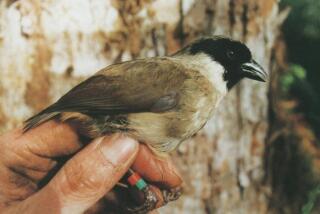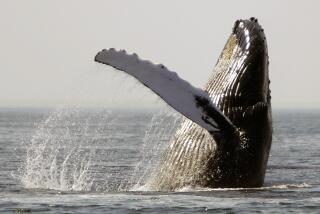Hundreds of Animal Species Nearly Extinct, Study Warns
- Share via
Despite international efforts to promote biodiversity, a new study has found that hundreds of the world’s animal species are in imminent danger of extinction, primarily in tropical mountains and islands in developing nations.
The report, published Wednesday in the journal Nature, concludes that while more than 10% of the Earth’s landmass is afforded some environmental protection, efforts are not being focused in places that have the greatest concentration of imperiled species.
The “global gap analysis” conducted by scientists for the group Conservation International studied mammals, amphibians, birds, turtles and tortoises -- which together represent just 1% of the planet’s species. But that was enough for the scientists to conclude in their report that urgent action is necessary to prevent hundreds of unique species from going extinct.
“This is the tip of the iceberg,” said Ana Rodrigues, a research fellow at the Center for Applied Biodiversity Science at the Washington-based Conservation International. “There is a window of opportunity here. Many species around the world are hanging on to little bits of habitat.”
“These findings confirm what we already know,” Rodrigues added: “The worldwide protection network is far from finished and we need to expand it into regions that need it most.”
The report found that at least 300 critically endangered species of animals exist in unprotected areas as well as 237 endangered and 267 vulnerable species. A critically endangered species is defined by the World Conservation Union as having a 50% probability of going extinct in 10 years.
The multiyear study relied on an analysis of computer databases and field studies at universities and government institutions around the world. The work is the beginning of a worldwide inventory of rare plants and animals that exist outside of protected areas.
Rodrigues cited Mexico as an example of a “mega-diversity” country, with hundreds of species that are not found anywhere else. But she said rare animals in the Sierra Madre mountains in southern Mexico are not protected. More than half of Mexico’s threatened amphibians are not protected, according to the study, along with about 30% of the country’s threatened mammals.
Rodrigues also identified sites in the Andes, on islands in Southeast Asia, on Madagascar and in southern India as areas of high biodiversity and low protection.
At last year’s World Parks Congress in Durban, South Africa, scientists said there was a global network of protected areas covering 11.5% of the Earth’s surface, a figure higher than the 10% goal scientists had set 10 years ago.
But Rodrigues said authorities need a more targeted approach to conservation and the flexibility to shift resources to poorer countries that have an abundance of unprotected species.
“It needs to be taken care of globally,” she said. “We need to help with capacity-building, help financially. These regions are well known to international conservation organizations for their importance. But this is the easy part. The action itself is another issue.”
More to Read
Sign up for Essential California
The most important California stories and recommendations in your inbox every morning.
You may occasionally receive promotional content from the Los Angeles Times.














